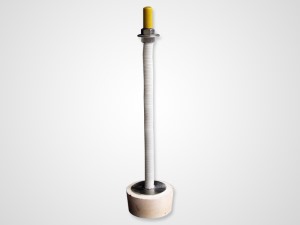What is the difference between rammer and castable?
What is the difference between rammer and castable?
1. The difference between raw material components: The ramming material is mainly composed of aggregate and powder with a certain particle gradation plus a binder, and the additive is mainly made of artificial or mechanical ramming construction of unshaped refractory materials. The ramming material includes corundum ramming. Ramming material, high alumina ramming material, silicon carbide ramming material, carbon ramming material, siliceous ramming material, magnesium ramming material, etc. For example, the ramming material for the bottom of electric furnace is made of silicon carbide, graphite, and electric calcined anthracite. It is a bulk material made of raw materials, mixed with a variety of ultra-fine powder additives, and fused cement or composite resin as a binder. It is used to fill the gap between the furnace body cooling equipment and the masonry or the filler for the leveling layer of the masonry. Pouring Refractory is a granular and powdery material made of refractory material with a certain amount of binder. It has high fluidity and is suitable for unshaped refractory materials formed by pouring. The three major components of the castable are the main components, plus The three kinds of ingredients and impurities are divided into: aggregates, powders and binders. The raw materials of aggregates are silica, diabase, andesite and waxstone.
2. The difference in the scope of application of construction: Luoyang Quantong Kiln Industry (ramming material manufacturer) recommends that the ramming material be used for uniform force and smooth construction during ramming construction. The ramming material is generally used for refractory brick masonry. Or for the kiln parts where masonry is difficult, the construction of the ramming material is relatively simple, and it is used to fill the gap between the cooling equipment of the furnace body and the masonry or the filling material for the leveling layer of the masonry. The castable is mainly used to construct the lining of various heating furnaces. Some high-quality varieties can also be used in smelting furnaces. For example, aluminate cement refractory castables can be widely used in various heating furnaces and other thermal equipment without slag and acid and alkali erosion. The parts where the working temperature is high due to corrosion by slag and slag, such as the tapping groove, ladle and blast furnace shaft, tapping groove, etc. And refractory castables made of high-quality granular and powdery materials with good sintering. Another example is phosphate refractory castables, which can be widely used in heating furnaces and soaking furnaces for heating metals, and can also be used directly in coke ovens and cement kilns. Parts in contact with materials. In some parts of metallurgical furnaces and other containers that are in direct contact with slag and molten metal, it is also effective to use high-quality phosphate refractory castables for repair. In general, castables can be used for key parts of the furnace body. The pouring molding of the furnace, such as the furnace door frame, near the feeding port; the molten metal pouring runner is generally formed by pouring the castable. After a period of use, the castable will fall off and need to be repaired regularly.

Related News
- Introduction of construction method of ramming material in intermediate frequency furnace
- How to choose the material of furnace lining
- The difference between rammer and castable
- Application direction of intermediate frequency furnace refining
- Introduction to the construction method of dry ramming material
- Do you know the production process and control points of breathable bricks?
- The application of argon blowing technology at the bottom of the intermediate frequency furnace
- Method for prolonging service life of intermediate frequency furnace lining
- In addition to diffused breathable bricks, there are those types of breathable bricks
- What are the advantages of coil cement
- What is the difference between refractory plastic and ramming material?
- 5 benefits of using dry ramming mixes
- Wear-resistant ramming material during the knotting process
- Furnace lining baking process sharing
- 4 main reasons for the damage of ladle breathable bricks
- Analysis of Characteristics of Refined Ladle Dispersion Type Breathable Bricks
- Specific analysis of the ventilation performance of the ventilation brick
- Factors Affecting the Effect of Argon Blowing Bricks at the Bottom of Ladle
- Composition and properties of ramming materials for glass kilns
- Phenomenon analysis of failure of argon blowing of ladle permeable bricks and how to improve the rate of argon blowing


